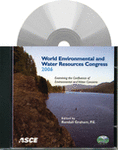Digital Floodplain Mapping and an Analysis of Errors Involved
Publication: World Environmental and Water Resource Congress 2006: Examining the Confluence of Environmental and Water Concerns
Abstract
Mapping floodplain boundaries using geographical information system (GIS) and digital elevation models (DEMs) was completed in a recent study. However convenient this method may appear at first, the resulting maps potentially can have unaccounted errors. Mapping the floodplain using GIS is faster than mapping manually, and digital mapping is expected to be more common in the future. When mapping is done manually, the experience and judgment of the engineer or geographer completing the mapping and the contour resolution of the surface topography are critical in determining the flood-plain and floodway boundaries between cross sections. When mapping is done digitally, discrepancies can result from the use of the computing algorithm and digital topographic datasets. Understanding the possible sources of error and how the error accumulates through these processes is necessary for the validation of automated digital mapping. This study will evaluate the procedure of floodplain mapping using GIS and a 3 m by 3 m resolution DEM with a focus on the accumulated errors involved in the process. Within the GIS environment of this mapping method, the procedural steps of most interest, initially, include: (1) the accurate spatial representation of the stream centerline and cross sections, (2) properly using a triangulated irregular network (TIN) model for the flood elevations of the studied cross sections, the interpolated elevations between them and the extrapolated flood elevations beyond the cross sections, and (3) the comparison of the flood elevation TIN with the ground elevation DEM, from which the appropriate inundation boundaries are delineated. The study area involved is of relatively low topographic relief; thereby, making it representative of common suburban development and a prime setting for the need of accurately mapped floodplains. This paper emphasizes the impacts of integrating supplemental digital terrain data between cross sections on floodplain delineation.
Get full access to this chapter
View all available purchase options and get full access to this chapter.
Information & Authors
Information
Published In
Copyright
© 2006 American Society of Civil Engineers.
History
Published online: Apr 26, 2012
ASCE Technical Topics:
Authors
Metrics & Citations
Metrics
Citations
Download citation
If you have the appropriate software installed, you can download article citation data to the citation manager of your choice. Simply select your manager software from the list below and click Download.
